Tracking your sleep routine can often lead to insights into all sorts of habits or quirks detrimental to a good night’s sleep. Before Apple Watch, apps promising to analyze your nightly resting patterns and devise remedies to improve on them were already plentiful. Yet after the release of the wrist-worn gadget, a new surge in the category ensued for its ease of use on watch and enhanced precision in measuring body movements at night.
In order to single out the creme de la creme of applications, we have put through their paces both standalone sleep trackers on iPhone and an array of apps requiring the assistance of Apple Watch.
No matter if you rock iPhone and Apple Watch together or solo, find out below which sleep trackers are worthwhile your time and money.
The best sleep trackers for iPhone
To cover all the bases we have contrived two sections: the first one is going to be dedicated to iPhone only applications whereas the subsequent one will revolve around all sleep trackers harnessing the power of iPhone and Apple Watch. If you’re here for Watch apps and don’t regard the first half as exhaustive, do make sure to read on as many of the watch compatible apps also function on their own.
Sleep Cycle Alarm Clock
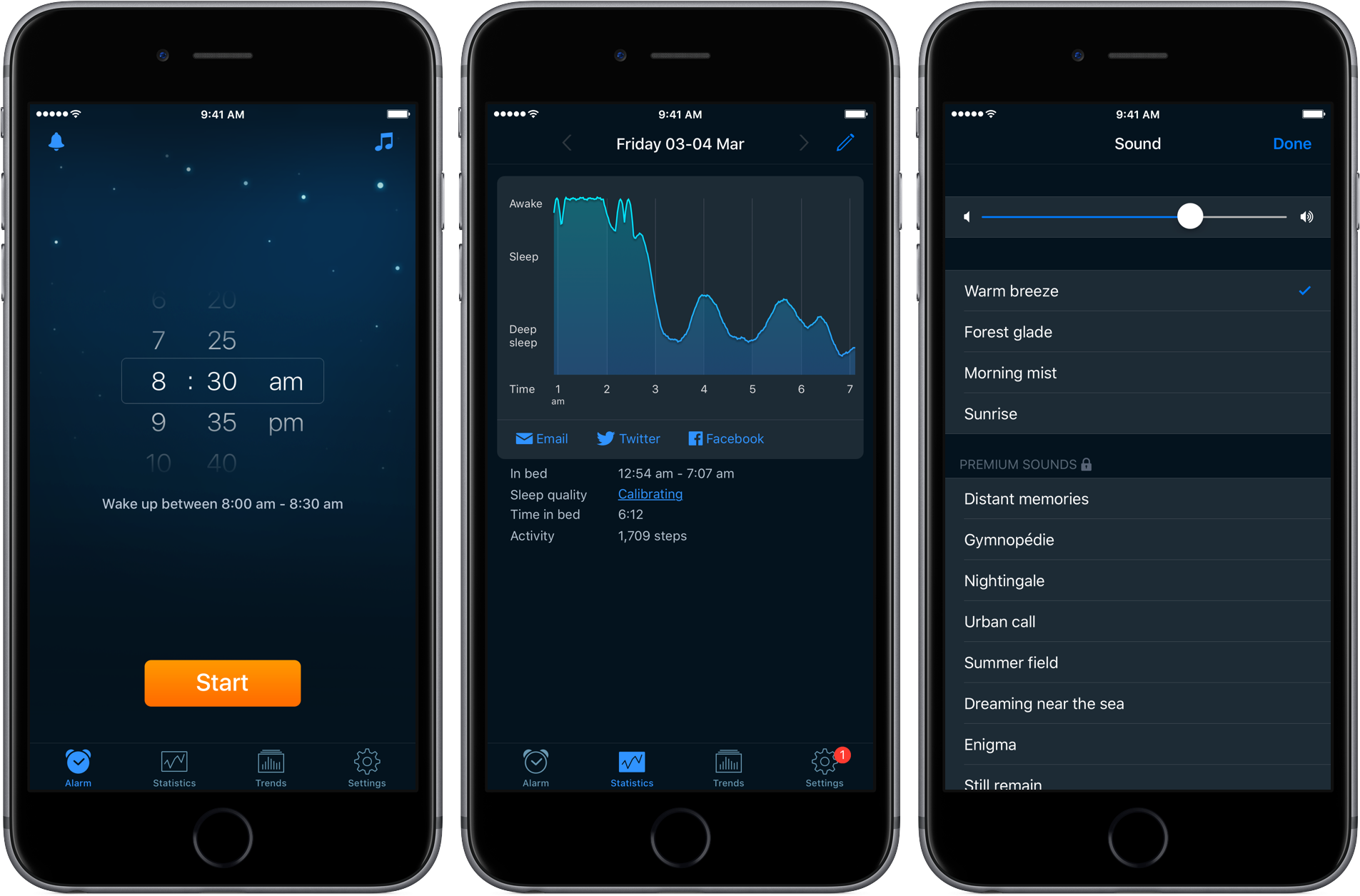
Sleep Cycle Alarm Clock is one of the most comprehensive apps in the field, posing an effective merger of alarm clock and sleep tracker. Notwithstanding their ultimate goal to get you hooked on the premium subscription service, the basic offer is available entirely free of charge to you, and that one alone is conceptualised well enough to make the cut.
Sleep Cycle Alarm Clock not only looks elegant but also houses a bevy of features such as intelligent alarms (so as not to rattle you when you are in a deep sleep phase) in the morning. The flagship feature however is the sleep tracking, for which Sleep Cycle Alarm Clock in fact offers two different methods of motion detection: your iPhone’s accelerometer or the microphone.
This in itself is pretty unique since most iPhone apps are designed exclusively around the device’s accelerometer, a trend bucked by Sleep Cycle Alarm Clock who claim to have pioneered a microphone based technology that obtains more precise results. On top of that, it is also advertised as superior to the accelerometer in a double bed environment.
UI wise the colors and animations are chosen well and when activated at night, your iPhone’s wake screen fades in and out softly and very easy on the eye.
Some of the more elaborate statistics are sadly hidden behind the premium subscription fee ($29 a year), but your arm isn’t twisted too badly by the developers at Northcube as the free ones sure enough fulfil their job. If you’re in the market for a sleep tracker that does not have to sit in the corner of your mattress while you sleep, this is one of the best out there.
- Device support: iPhone, iPad
- Notable features: Microphone motion detection, intelligent alarms, sleep quality and activity analytics (Premium)
- Cost: Free (in-app subscription service)
Good Morning Alarm Clock

Good Morning Alarm Clock’s offering closely mirrors what has already been discussed, however with two interesting points of difference that make for a slightly different flavor at large.
For one, the home screen comprises an alarm clock and a weather extension, making the hub of the app somewhat more informative.
Upside number two comes in the form of an under the hood feature that should be regarded indispensable by anyone (but unfortunately is not): HealthKit integration.
On the flip side, there is a sizeable amount of in-app ads clogging the free version of Good Morning Alarm Clock (the App Store has a paid-for pendant if you grow fond of it) and the only viable method to detect your nightly motions is by way of your iPhone’s accelerator. I’m not slating the technique, it’s just nice to have choices.
- Device support: iPhone, iPad
- Notable features: HealthKit Integration, Weather extension, Intelligent alarms
- Cost:$4.99
By and large you have two solid options in Sleep Cycle Alarm Clock and Good Morning Alarm Clock, two apps that are similar enough to be mentioned in the same breath but at the same time different enough for two seperate entries.
Honorable Mention
Stock Clock App: Bedtime
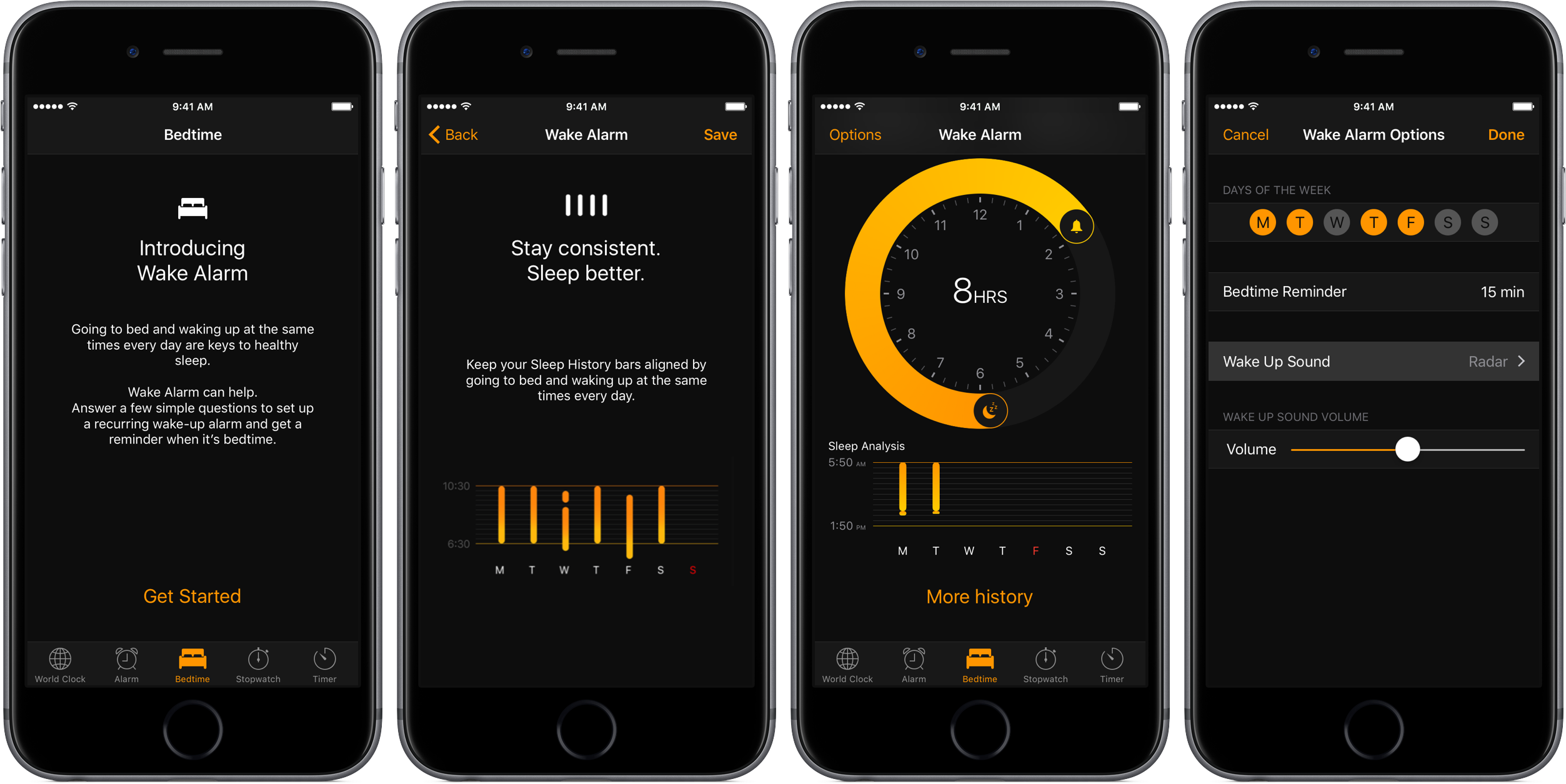
Despite the somehow differing value proposition, we can’t brush past this one without at least mentioning it. Since the introduction of iOS 10, Apple has seriously ramped up their own efforts at providing guidance for healthy sleeping habits.
As a consequence, the bedtime feature inside your stock Clock app now boasts smart bedtime alerts and morning alarms based on your desired sleep duration. It also has a tentative go at sleep analytics, which tie nicely into your Health app. If you’re satisfied with an assistant that pushes you towards a healthier sleep cycle this could be up your alley, but don’t expect it to supplant a refined sleep tracker app. Find out more about Bedtime here.
The best sleep trackers for Apple Watch
With Apple Watch, the days of carefully planting your iPhone on the mattress are over. In fact in many cases your iPhone is no longer required at all, until you want a closer look or breakdown of your accrued sleep stats that is. Such being the case, here are the best trackers available on both iOS and watchOS that work in tandem to shoulder the workload intelligently.
Sleep++
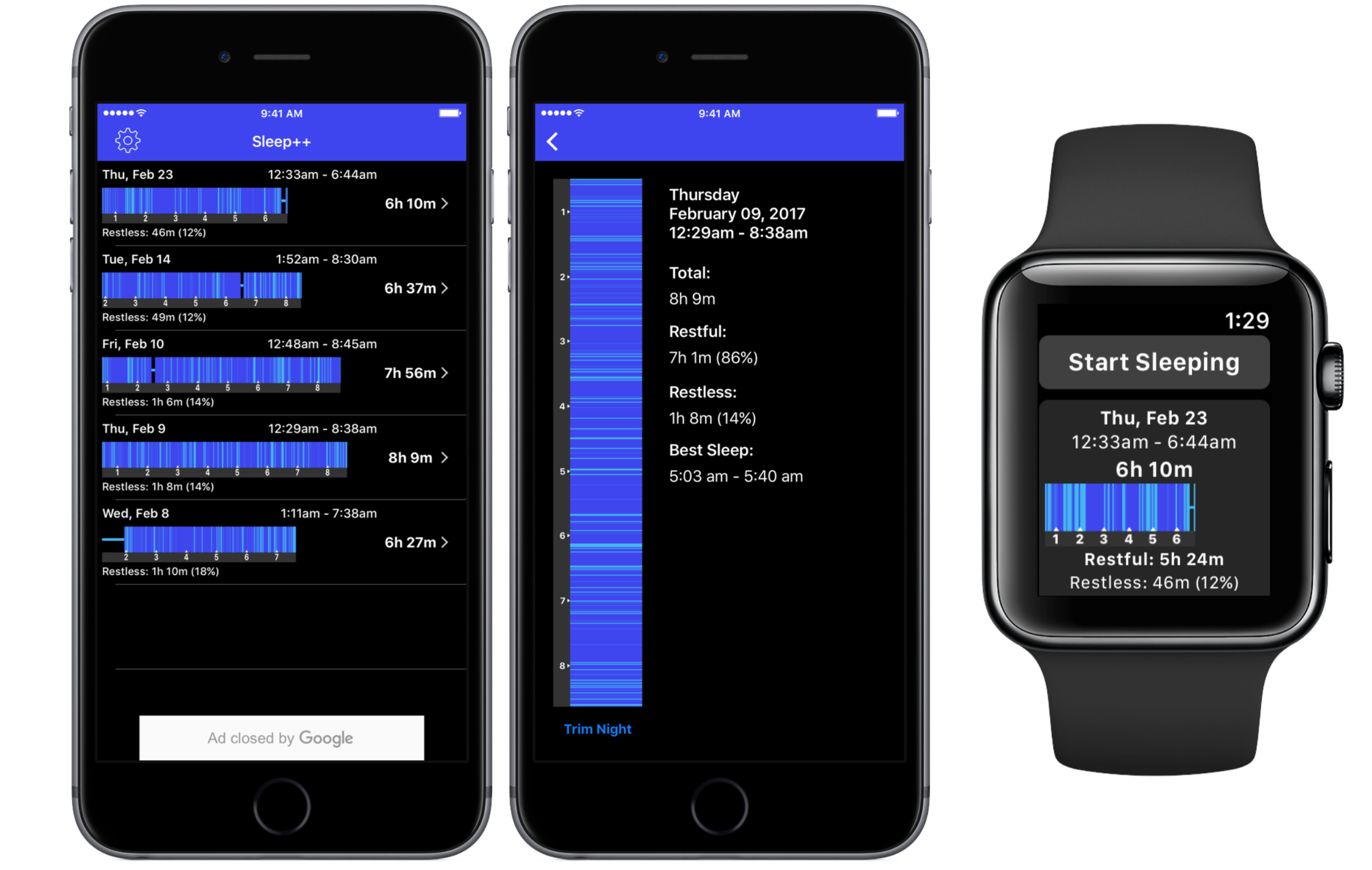
Condensed in one word, Sleep++ is minimalist. This is a good thing in a sea of apps clamoring for your details, your money or even third party tracking devices that exclusively work with the sleep tracker you just downloaded.
Sleep++ does away with all the clutter and delivers an experience stripped to the bare minimum, but in doing so, fashions a reliable symbiosis between watch and iPhone plus easy to read statistics.
If you are quick to worry about your watch’s battery life, you will appreciate the fact that Sleep++ launches and tracks completely disconnected from your iPhone, meaning you can toggle on Airplane Mode before starting your snooze and your watch will emerge relatively undrained in the morning.
Start and finish your sleeping session on your wrist and at the next opportunity, your watch will transmit the data recorded to your iPhone for a pretty simplistic but sufficient visualization of your night.
The implications of minimalist in this instance are no weekly analytics or trends, no heartbeat monitoring and also no notifications or widgets on your iPhone. It does however tie nicely into HealthKit, which is the minimum bar to clear considering Apple’s push for Health in iOS 10.
Provided you feel as if you can forego some fancier metrics and chiefly care for an assessment on how steady a sleeper you are, this is a perfect starting point at no cost. If you want to support the developer and purge the app of (fairly minor) ads, you can flick that switch for $1.99.
- Device support: iPhone, iPad, Apple Watch
- Notable features: HealthKit integration, lets you use Airplane Mode on watch
- Cost: Free (in-app purchase)
Sleep Diary
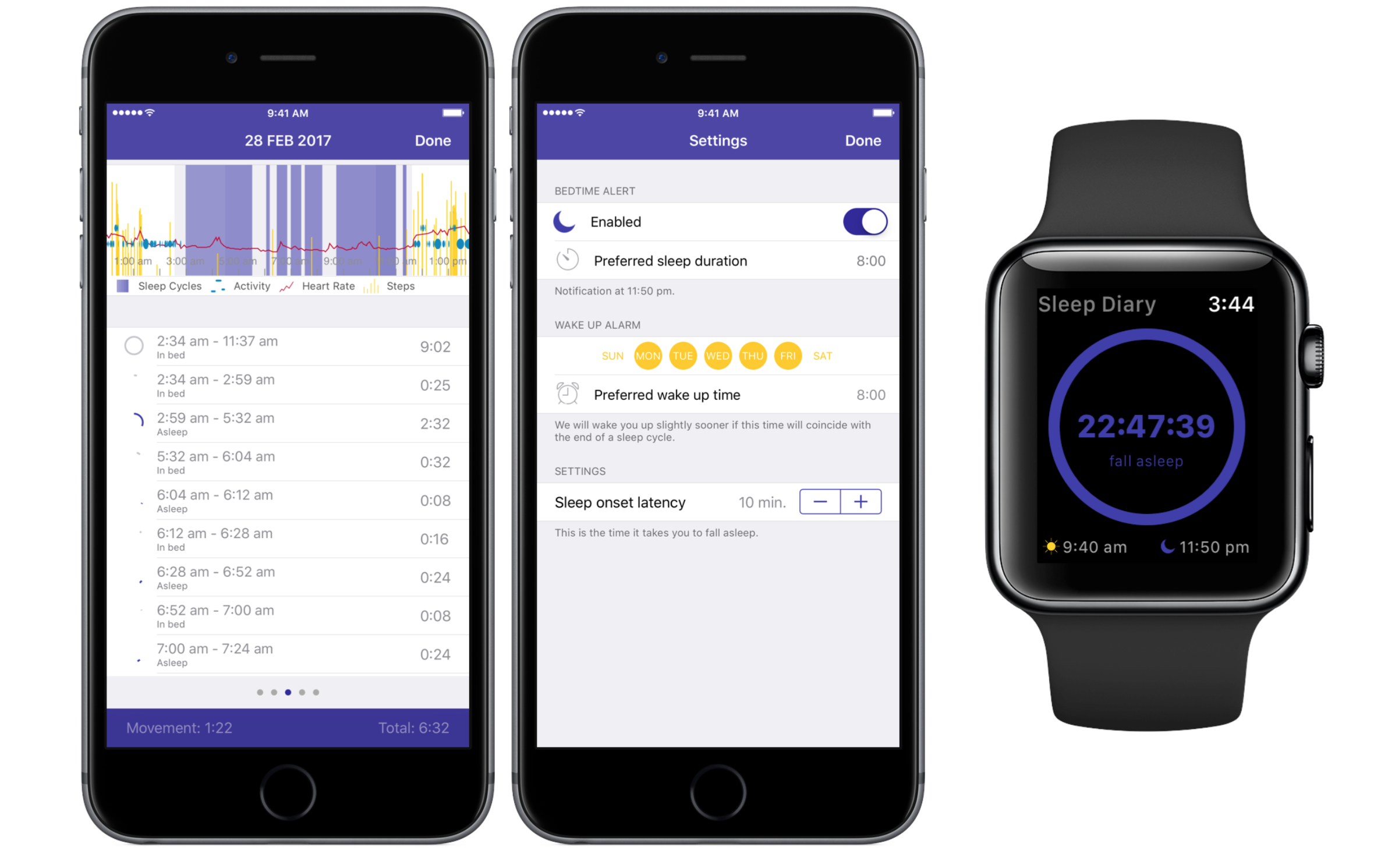
In terms of feature density, Sleep Diary is a whole different animal. While the mechanics of the tracking process remain the same (start and stop your bedtime manually on your watch), the core function is embedded in a slew of complementary features ranging from dispensable to pretty quintessential.
On the negligible end of the scale we can find stuff like a bedtime countdown widget for your iPhone, which will strike most as a little gimmicky, then again on the other end of the aisle, Sleep Diary boasts sage settings such as wake up and bedtime alerts (pushed to your wrist) based on your set sleep duration and a box for ‘sleep onset latency’ – because most people don’t fall asleep without delay.
Most importantly though, the watch is capable of capturing your heartbeat data in addition to the movement tracking, which makes for another enticing layer of data to analyze in the statistics. Sudden spikes in your heart rate at night can be indicative of various circumstances or conditions, and the ability to monitor that is hands down a big plus.
Once on your wrist, the app also operates entirely disconnected from your iPhone. Whenever connected next, it will feed the app and HealthKit with the intel. There is very little to gripe about here, so let’s not grasp at straws just for the sake of it, especially considering Sleep Diary is available to download for free. If you want a comprehensive tracker that also helps you maintain a healthy sleep rhythm, by all means give this one a go.
- Device support: iPhone, iPad, Apple Watch
- Notable features: HealthKit integration, use Airplane Mode on watch
- Cost: Free (in-app purchase)
Sleep Tracker (SleepMatic)
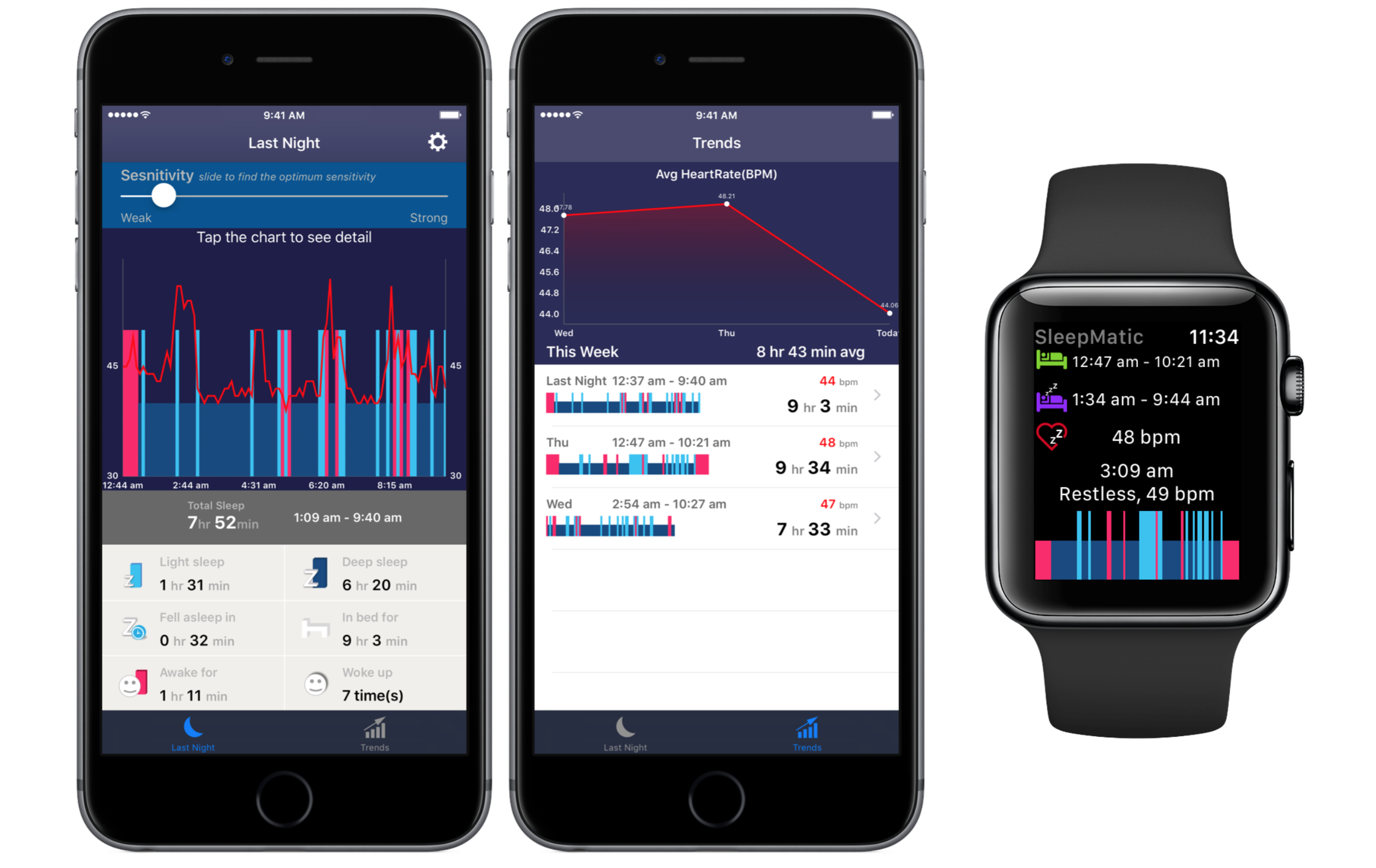
Dipping our toes into sleep trackers hiding behind a paywall, SleepMatic ($1.99) sticks out for two defining reasons. Interestingly, these are features hard to find amongst the freebies hence if you can pony up the money equivalent to a cup of coffee, this investment will undoubtedly be the more wholesome one for your sleep.
As far as hitting the ground running, paid-for apps are generally unmatched in their experience in that the minute they are downloaded, you are good to go. This holds true for SleepMatic too, which will not pry into your personal details or data but is ready to serve from the get-go. This positive aside, the two standout features here are automatic sleep tracking (meaning no manual start and stop sleep button on watch) and a movement sensitivity lever to better tailor the recorded data to your sleeping type for improved measuring accuracy.
Both of these treats make SleepMatic a more effortless tracker in their own way: the perks of not having to remember enabling and disabling sleep tracking every night and morning respectively are self-evident, while scrubbing the sensitivity scale up and down can retrospectively edit results for the better or worse to precisely capture your sleep quality.
To give you one example of how this works, when the app detected me waking up seven times (because I like to toss, turn and kick in my sleep) but I only recall two incidents, I can dial down sensitivity until that count has shrunken accordingly. This allows for continuous adjustments until you have found a sensitivity level that reconciles data and real life experience, something that will give you great confidence in future results.
In addition to the showpiece features, SleepMatic keeps tabs on your heart rate as well. Furthermore it boasts a neat widget on your iPhone, bedtime alerts, works untethered on your watch (which displays a great deal of information) and of course also features seamless integration with HealthKit.
- Device support: iPhone, iPad, Apple Watch
- Notable features: Automatic sleep tracking, sensitivity settings, HealthKit integration, lets you use Airplane mode on watch
- Cost: $1.99
Pillow
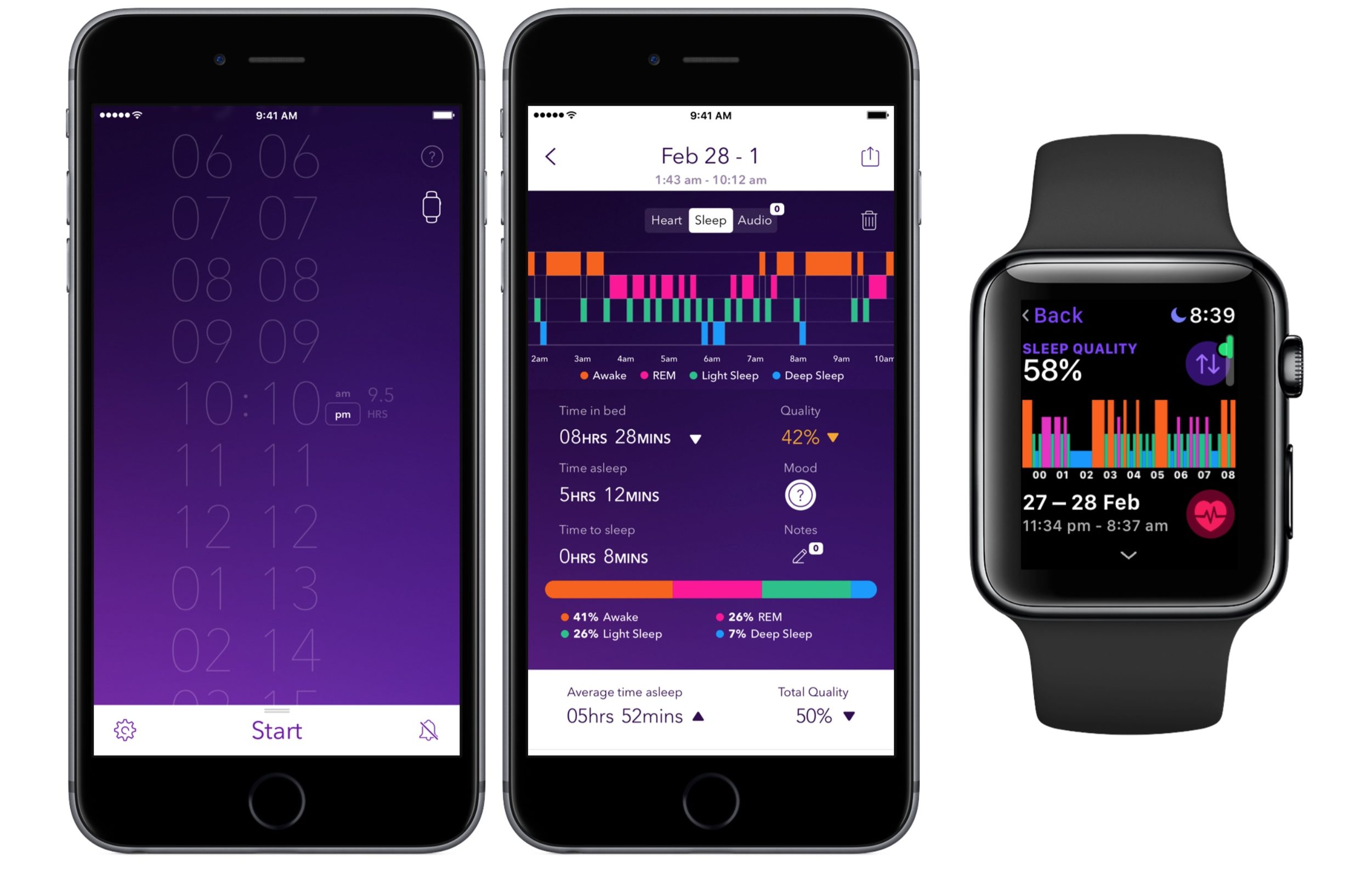
Pillow is visually stunning on both iOS and your Apple Watch, but it is more than just a pretty facade. Under the hood, Pillow offers solid sleep and heart rate tracking (however manually initiated every evening) and on top of that, an audio layer to record snoring or other anomalies at night.
The utility of such feature strongly hinges on the type of sleeper, even so it can prove vital for users (unknowingly) suffering from pesky conditions like sleep apnea or less grave issues. Having this additional layer and the option to correlate noise spikes with your heart rate or sleep phases is straight up terrific.
Next to noise recordings and the neat looks, Pillow promotes sleep goals and derives smart bed and wakeup times from it. Laudably, it bolsters a function called ‘sleep aid’ that will play calming sounds from your iPhone until your watch determines you have fallen asleep. By the same token, ‘smart wakeup’ functions conversely, ensuring the alarm will not go off before you have ascended from a deep sleep phase and entered the territory of light sleep.
There are more whistles and bells (a sleep lab, power-nap mode, in-depth statistics, etc) available for an in-app purchase valued at $4.99 – yet the basic outfit of Pillow is more than serviceable on its own.
As always, the service interlocks hassle-free with HealthKit and iCloud synchronisation is offered to relay your data to the even larger screen of your iPad. In turn, it passes on a widget for your iOS devices, which is not a major loss in our book as most apps haven’t been able to provide additional value through that window anyway. If you are not religiously opposed to creating a profile with Pillow (the downside of free apps) and want form over function, this one is absolutely worth a shot.
- Device support: iPhone, iPad, Apple Watch
- Notable features: Noise recording, sleep aid and smart alarm, HealthKit integration, Airplane mode on watch, power nap (premium).
- Cost: Free (in-app purchase)
AutoSleep
AutoSleep is one of the behemoths in the sleep tracker category: powerful, rich in features, available across all your devices. By the same token, the app is arguably unrivalled when it comes to the level of sophistication in measurements and handoff capabilities between devices. That is, it deploys elaborate algorithms to track your sleep on either iPhone or Apple Watch and clocks your bedtime accurately, most of the time without you even noticing.
To flesh it out a little, AutoSleep is going to automatically detect the device best suited for tracking your night, then work its magic: provided you sleep with your watch on, copious data is going to be drawn from there and subsequently added to and analyzed on your iPhone. If you prefer to charge your Apple Watch over night, AutoSleep falls back on your iPhone’s data such as how often it has moved, been switched on and off et cetera. All of this is automated and no ‘bedtime switch’ needs to be flicked on either device before resting your eyelids.
In order to ensure precise breakdowns of your nightly naps, the app comes with an intelligent setup wizard. I strongly recommend working through that brief set of questions at the very beginning of your AutoSleep journey, as it will further enhance your measurements. What’s not to like? Not much obviously. All the same, Autosleep’s biggest strength – the vast array of data and graphs stored on iPhone – in a sense comes at a price, and I’m not referring to the $2.99 entry ticket asked for on the App Store.
Instead, the app is capable of displaying so many (nifty) data points and information that ironically it is likely to feel smothering or daunting to the large, laid-back constituency on iOS. In other words, this ain’t your gateway drug to sleep tracking, it’s the endgame.
- Device support: iPhone, Apple Watch
- Notable features: HealthKit integration, daily, weekly and monthly sleep analysis, Activity Ring like visualization of results including rings for sleep, move, heart rate, device charge, daylight.
- Cost: $2.99
Honorable Mentions
Sleep Watch (Free, in app purchase)
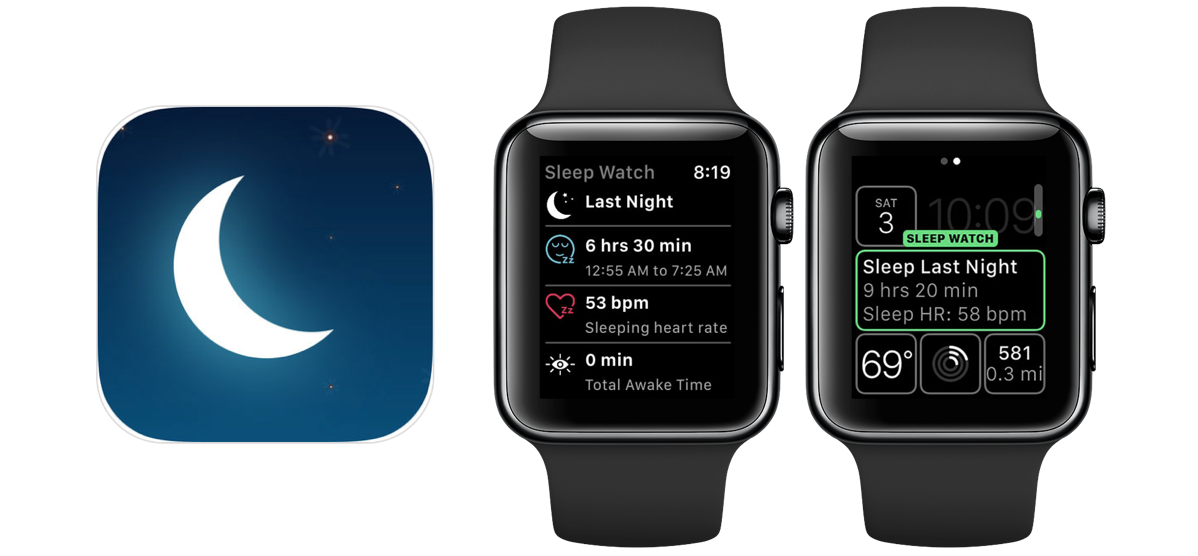
Like SleepMatic, Sleep Watch does a great job at tracking and archiving your sleep all week around, and like SleepMatic it is going to cost you a little bit of money upfront. In this case we are talking about five bucks, which is why it took a back seat to the comparatively cheaper SleepMatic.
Make no mistake though, this one is slick and if you’re unperturbed by the cost of it, you get the extremely convenient auto sleep detection feature (meaning no on/off switching every day), notifications on how you’re faring throughout the week and a neat watch face complication to round it off. Sleep Watch turns your Apple Watch into a very capable sleep tracker and should be worth a thought or two if you are serious about your sleeping habits.
- Cost: Free
SleepRate – Sleep Therapy (Free, in app purchase)
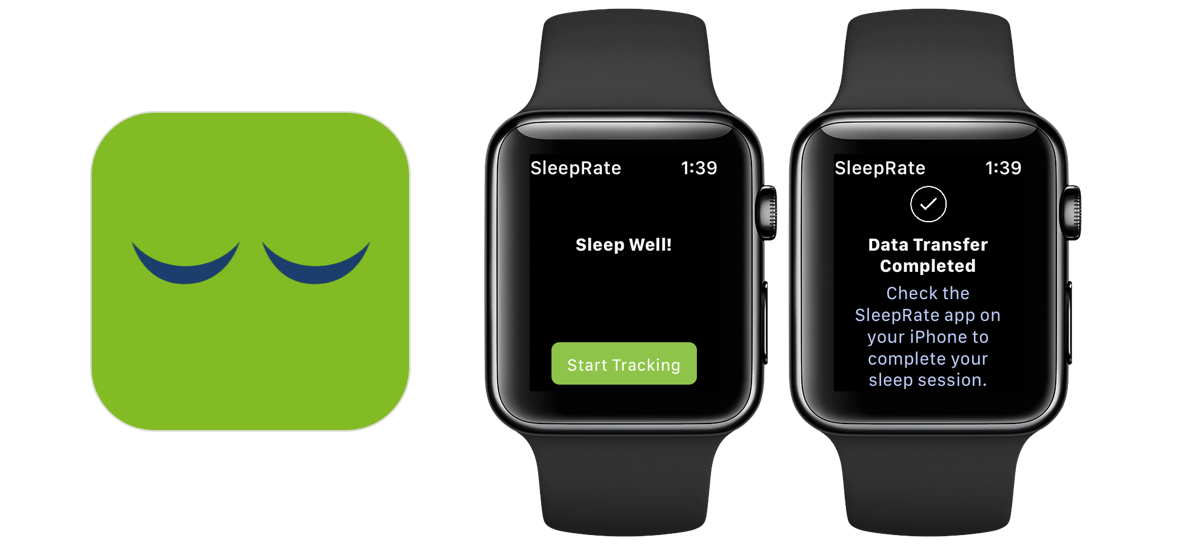
At the onset, SleepRate was a sure candidate for the winners’ list, but during the time of testing, it occasionally failed to transfer data to the iPhone in the morning, which is naturally extremely frustrating.
Whenever it works, the data provided on iPhone is great and offers a refreshing twist in that before and after starting the tracking on Apple Watch, you will have to answer a couple of questions on iPhone about naps and fatigue throughout the day and sleep quality after your night. This data is subsequently taken into account in the evaluation of your watch records and overall sleep ratings – a clever means to make the data more reliable and personal.
Regrettably, your patience might start wearing thin if the data transmission fails repeatedly in the morning. If you’re a risk taker, try your luck.
- Cost: Free
It ain’t over till the fat lady sings!
The App Store has become a vessel filled to the brim with sleep related applications, some good, some absolute duds. The ones compiled above obviously only make for a small selection of apps – but at least we can vouch for their quality. With all that said, if you are counting on an app not discussed above or want to throw your support behind a particular one, let us know in the comments: what do you think is the best app to track your sleep?